
| Home | Deepsky Atlas | TheAstronews | Links | Solar System | ||||||

Hawaiian Astronomical SocietyConstellations: Ursa Major -- Demonstrating how People Change |
||||||||||
Callisto was the daughter of Lycaon, king of Arcadia. So attractive was she that Zeus fell madly in love with her. Eventually Callisto gave birth to a baby boy, naming him Arcas. Hera, forever the jealous wife of Zeus, grew furious over the affair, and demanded her husband stop seeing Callisto. Zeus paid no attention to Hera, and kept seeing Callisto. Hera decided it was time for drastic action. She changed Callisto into a shaggy bear and left her wandering in the Arcadian forests.
Years later, Callisto's son Arcas grew into a handsome young man. He enjoyed hunting very much. One day, Callisto spotted her son hunting in the forest. So happy and excited was she, that she forgot she was a shaggy bear. She wanted to hug Arcas, and tell him that she loved him dearly. Arcas looked up, and saw a fierce bear approaching quickly. He had no idea that it was his own mother.....to him it was a vicious bear about to kill him. He drew his bow on the approaching bear. Luckily, Zeus was watching. Before Arcas could shoot his mother, Zeus grabbed Callisto's tail and flinging her into the heavens where she became Ursa Major. Zeus wanted Arcas with his mother, so he changed his son into a bear as well, and grabbed his tail and flung him into the heavens, where he became Ursa Minor. Both Ursa constellations have unrealistically long tails because they were stretched out when Zeus threw them. (I wonder why Zeus couldn't change Callisto back to a human instead).
Hera, still not satisfied, begged her brother Poseidon (the sea god) never to let the pair of bears rest. So even now, Ursa Major and Ursa Minor turn around the circumpolar sky without resting (setting). Of course, from Hawaii's latitude Ursa Major does set and rest.
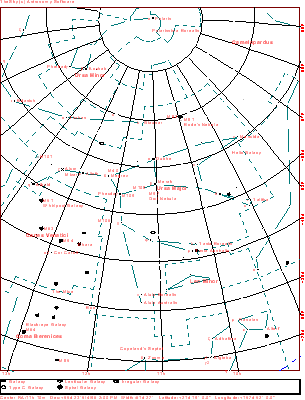
Click the map for a 916x1200 version of the above. Click here for a map better suited for use in the field.
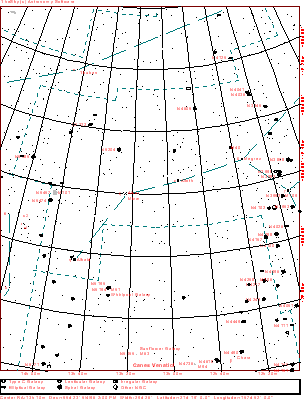
This a more detailed view of the constellation. The map displays stars to magnitude 10, and deepsky objects to magnitude 12. Click here for a map better suited for use in the field.
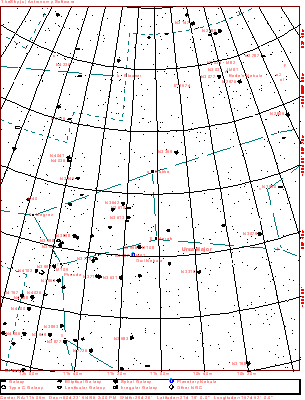
Click here for a map better suited for use in the field.
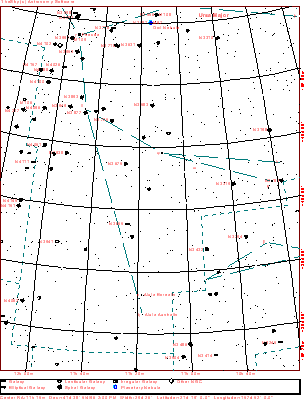
Click here for a map better suited for use in the field.
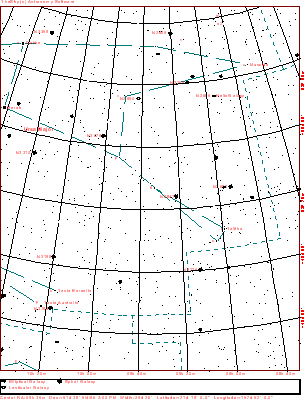
Click here for a map better suited for use in the field.
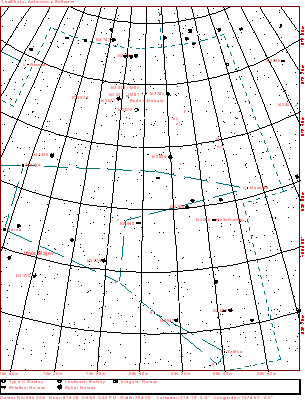
Click here for a map better suited for use in the field.
M101 (NGC5457) is a large (29'x27') fairly bright (mag. 7.9) galaxy. Located 5.5° NNE of Alkaid (the tip star of the Big Dipper's handle) it appears dimmer than it's magnitude rating implies. A good 8-10" telescope should begin to see hints of spiral structure and bright knots.
| Map | Printable Map | More info. |
 19k GIF. This image of M101 is a summation of nine separate images of the galaxy. Each exposure was five minutes in duration. The individual images were combined using SkyPro software and then deconvoluted with Hidden Image software. The final image was then adjusted for overall gamma to display the central structure and the outer structure clearly at the same time in the final image. The shots were taken with an 8" f/6 SCT, ST6, clear filter, while running The Sky and SkyPro software. The telescope was being controlled remotely. Photo by Tim Puckett. 19k GIF. This image of M101 is a summation of nine separate images of the galaxy. Each exposure was five minutes in duration. The individual images were combined using SkyPro software and then deconvoluted with Hidden Image software. The final image was then adjusted for overall gamma to display the central structure and the outer structure clearly at the same time in the final image. The shots were taken with an 8" f/6 SCT, ST6, clear filter, while running The Sky and SkyPro software. The telescope was being controlled remotely. Photo by Tim Puckett. |
 23k JPEG. M101 taken with C8 and ST7. 2 x 20 minutes exposure at f/6.3 -- Benoit Schilling 23k JPEG. M101 taken with C8 and ST7. 2 x 20 minutes exposure at f/6.3 -- Benoit Schilling |
 10k JPEG. NGC4605 is an edge on spiral galaxy located 5.5° northeast of Megrez (Delta Ursae Majoris, the star at the junction of Dipper's bowl and handle). Dreyer describes it as bright, large, very much elongated (in p.a. 118°), and with a little, gradual brightening toward the middle. 10k JPEG. NGC4605 is an edge on spiral galaxy located 5.5° northeast of Megrez (Delta Ursae Majoris, the star at the junction of Dipper's bowl and handle). Dreyer describes it as bright, large, very much elongated (in p.a. 118°), and with a little, gradual brightening toward the middle.
Image by Lenny Shaffer taken with a 10", f6 Newtonian and a Cookbook TC245 CCD camera, taken April 11, 1997. Ten, one minute exposures with dark frames, and then processed further in Photoshop.
|
 10k GIF. M40 is not a deepsky object, but a double star found 1.4° NE of Megrez (Delta Ursae Majoris). It forms a nice triangle with the mag. 12.7 galaxy NGC4290 (visible in a 6") and the star 70 Ursae Majoris. I have included a map this time, rather than a photograph. 10k GIF. M40 is not a deepsky object, but a double star found 1.4° NE of Megrez (Delta Ursae Majoris). It forms a nice triangle with the mag. 12.7 galaxy NGC4290 (visible in a 6") and the star 70 Ursae Majoris. I have included a map this time, rather than a photograph.
|
 31k Labeled JPEG. Three brightish spiral galaxies lie a degree apart from each other, and about 3.5° SSE of Phecda (Gamma Ursae Majoris). NGC4088 (Best 100) is the brightest of these. Described as bright (mag. 11.1), quite large (5.7'x2.2'), elongated (in p.a. 55), with a little brighter middle, an 8" will show mottled arms, and an off center stellar nucleus. 31k Labeled JPEG. Three brightish spiral galaxies lie a degree apart from each other, and about 3.5° SSE of Phecda (Gamma Ursae Majoris). NGC4088 (Best 100) is the brightest of these. Described as bright (mag. 11.1), quite large (5.7'x2.2'), elongated (in p.a. 55), with a little brighter middle, an 8" will show mottled arms, and an off center stellar nucleus.
NGC4085 lies 12' to the south. Dreyer describes it as bright (mag. 13), fairly large (2.8'x0.8'), with fairly pronounced elongation (p.a. 78°). It brightens very suddenly toward the middle. The brighter middle is more obvious in 12" and larger instruments. NGC4026 (Best 99) lies 1.1° WNW of NGC4088. Dreyer says it is very bright (mag. 11.7), quite large (5.2'x1.3'), much elongated (p.a. 176°), and with a very sudden and pronounced nucleus ("vsvmbMBN," for all you fans of NGC codes). A nice, edge on spiral.
Image is a two download mosaic from the Digital Sky Survey.
|
 76k JPEG. Often overlooked barred Spiral Galaxy M109 (NGC3992) in Ursa Major. Located .5° SE of Phecda, the south-easten bowl star of the Big Dipper, it shines at mag 10.6. It measures 8'x5' minutes in size. 76k JPEG. Often overlooked barred Spiral Galaxy M109 (NGC3992) in Ursa Major. Located .5° SE of Phecda, the south-easten bowl star of the Big Dipper, it shines at mag 10.6. It measures 8'x5' minutes in size.
Photographer's notes: Full resolution image (9 micron pixels) using HiSIS (KAF400) CCD Camera. 5 - 180sec exposures = 15 minutes at f6.3. Compare with 120 inch Lick photo in Galaxies by T. Ferris. Image kept light to show small (spiral?) galaxy at left edge. David Ratledge
|
 20k JPEG. NGC3941 (Best 98) is a spiral galaxy located in southeastern Ursa Major. It sits on a line between the mag. 3.7 Alula Borealis (Nu Ursae Majoris, 8° separation) and the mag. 2.8 Cor Caroli (Alpha Canum Venaticorum, 12.5° separation). Described as very bright (mag. 11), fairly large (3.5'x2.3'), round, with a mag. 9 star involved. The "star" is actually a stellar nucleus, just visible at higher power in an 8". The mag. 6.5 SAO62754 lies 31' to the ESE. 20k JPEG. NGC3941 (Best 98) is a spiral galaxy located in southeastern Ursa Major. It sits on a line between the mag. 3.7 Alula Borealis (Nu Ursae Majoris, 8° separation) and the mag. 2.8 Cor Caroli (Alpha Canum Venaticorum, 12.5° separation). Described as very bright (mag. 11), fairly large (3.5'x2.3'), round, with a mag. 9 star involved. The "star" is actually a stellar nucleus, just visible at higher power in an 8". The mag. 6.5 SAO62754 lies 31' to the ESE.
Image is from the Digital Sky Survey.
|
 91k Labeled JPEG. NGC3877 (Best 97) is one of three major galaxies, and several minor ones, in an area of sky covering 1.5° of sky. It sits 17' south of the star Chi Ursae Majoris, just south of the bowl of the Dipper. Dreyer describes it as bright (mag. 11.9), large (5.5'x1.3'), and moderately elongated (in p.a. 37°). 91k Labeled JPEG. NGC3877 (Best 97) is one of three major galaxies, and several minor ones, in an area of sky covering 1.5° of sky. It sits 17' south of the star Chi Ursae Majoris, just south of the bowl of the Dipper. Dreyer describes it as bright (mag. 11.9), large (5.5'x1.3'), and moderately elongated (in p.a. 37°).
NGC3893 sits 1° NNE of Chi Ursae Majoris. The description reads bright (mag. 10.9), fairly large (4.4'x2.7'), round, and much brighter toward the middle. Increasing aperture helps brighten the middle, as well as produce a mottled appearance. Its very small (1.4'x1.0'), faint (mag. 13.9) companion, NGC3896 sits 5' to the southeast. NGC3893 makes a good jumping off point for three small faint galaxies. NGC3938 (mag. 13, 1.5') lies 31' to the east and is the easiest. NGC3932 is more difficult (mag. 15, 1.1'x0.5') and lies another 15' SSE. NGC3906 may be the most difficult of all (brighter at mag. 13.8, but larger too at 1.9'x1.7') and lies 20' southeast of NGC3893. NGC3949 lies 1.3° east of Chi Ursae Majoris, and is the third bright galaxy of the group. Dreyer says it is quite bright (mag.11.6), fairly large (2.9'x1.6'), pretty much elongated (p.a. 120°), and brightening gradually toward the middle.
Image is a four download mosaic from the Digital Sky Survey.
|
Image to the left is from the Digital Sky Survey and includes 56 Ursae Majoris. Image to the right comes from Zsolt Frei's and James E. Gunn's Galaxy Catalog.
|
 94k GIF. M97 (NGC3587) is a rather faint (mag. 11.2) planetary nebula located 2.3° ESE from Merak, the southwestern star of the Big Dipper's bowl. Dreyer optimistically describes it as very bright. He also calls it large (3'), round, possessing a bright middle and gaps. These gaps form the "eyes" of the Owl Nebula. They require dark skies, and a good 10" telescope. The galaxy M108 (NGC3556) lies .8° NW, and at the top, right of this image from the Digital Sky Survey. M108 is considered bright (mag. 10.7), quite large (8.7'x2.3'), very elongated (PA 79°) and condensed. Countless galaxies fainter than mag. 15 inhabit this image. 94k GIF. M97 (NGC3587) is a rather faint (mag. 11.2) planetary nebula located 2.3° ESE from Merak, the southwestern star of the Big Dipper's bowl. Dreyer optimistically describes it as very bright. He also calls it large (3'), round, possessing a bright middle and gaps. These gaps form the "eyes" of the Owl Nebula. They require dark skies, and a good 10" telescope. The galaxy M108 (NGC3556) lies .8° NW, and at the top, right of this image from the Digital Sky Survey. M108 is considered bright (mag. 10.7), quite large (8.7'x2.3'), very elongated (PA 79°) and condensed. Countless galaxies fainter than mag. 15 inhabit this image.
|
 91k JPEG. NGC3184 (Best 95) is a spiral galaxy located in southwestern Ursa Major, just north of Leo Minor. The nearest "bright" star is Tania Australis (Mu Ursae Majoris), 46' to the east. Dreyer's description reads fairly bright (mag. 10.5), very large (7.4'x7.0'), round, and brightening only very gradually toward the middle. Several other galaxies inhabit this image, the most significant of them is NGC3179. lying 19' south of NGC3184, it shines at mag. 14.1 and covers 1.8'x0.5'. It's small size compensates a little for its dimness. 91k JPEG. NGC3184 (Best 95) is a spiral galaxy located in southwestern Ursa Major, just north of Leo Minor. The nearest "bright" star is Tania Australis (Mu Ursae Majoris), 46' to the east. Dreyer's description reads fairly bright (mag. 10.5), very large (7.4'x7.0'), round, and brightening only very gradually toward the middle. Several other galaxies inhabit this image, the most significant of them is NGC3179. lying 19' south of NGC3184, it shines at mag. 14.1 and covers 1.8'x0.5'. It's small size compensates a little for its dimness.
Image is from the Digital Sky Survey. Tania Australis sits to the left (east) of NGC3184 in this picture.
|
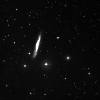 43k JPEG. NGC3079 (Best 93) is the primary galaxy to view in this group of three. Indeed, below 8" will hardly stand a chance seeing more than one. They lie in western Ursa Major, 2.1°rees northeast of the mag. 4.6 Phi Ursae Majoris. Dreyer describes NGC3079 as very bright (mag. 10.6), large (7.5'x1'), and moderately elongated (Dreyer says the position angle is 135 °, others give 165°). Steve Coe reports glimpsing a dark lane with a 13". 43k JPEG. NGC3079 (Best 93) is the primary galaxy to view in this group of three. Indeed, below 8" will hardly stand a chance seeing more than one. They lie in western Ursa Major, 2.1°rees northeast of the mag. 4.6 Phi Ursae Majoris. Dreyer describes NGC3079 as very bright (mag. 10.6), large (7.5'x1'), and moderately elongated (Dreyer says the position angle is 135 °, others give 165°). Steve Coe reports glimpsing a dark lane with a 13".
The other galaxies are the very faint NGC3073 (mag. 13.7, 1.3'x1.2', and 11' west of the southern tip of NGC3079) and the even fainter MCG9-17-9 (mag.14.8, 0.8'x0.3', and 7' west of the northern tip of NGC3079).
Image is a second generation, blue light image from the Digital Sky Survey.
|
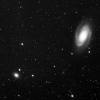 91k JPEG. NGC3077 (Best 94) is a galactic companion to M81 (M81 lies 47' to the northwest). Dreyer's description reads quite bright (mag. 10.8), quite large (5.3'x4.4'), much brighter toward the middle, and then the peculiar comment "round with ray." A 12" class instrument might catch the "ray" with averted vision, as well as the nearly stellar nucleus. 91k JPEG. NGC3077 (Best 94) is a galactic companion to M81 (M81 lies 47' to the northwest). Dreyer's description reads quite bright (mag. 10.8), quite large (5.3'x4.4'), much brighter toward the middle, and then the peculiar comment "round with ray." A 12" class instrument might catch the "ray" with averted vision, as well as the nearly stellar nucleus.
Image form the Digital Sky Survey includes the much larger M81 (top, right) along with NGC3077 (bottom, left).
|
 M82, 42k GIF. M81 (NGC3031, sometimes called Bode's nebula) and M82 (NGC3034) are a pair of bright (mags. 7.9 & 9.2) galaxies located 10° NW of Dubhe, the northwestern star of the bowl of the Big Dipper. Separated by .5°, they make a beautiful pair. M81 is a classic spiral (size 27'x14'). M82 (size 11'x4') looks a little strange, even when viewed visually through a telescope. M82, 42k GIF. M81 (NGC3031, sometimes called Bode's nebula) and M82 (NGC3034) are a pair of bright (mags. 7.9 & 9.2) galaxies located 10° NW of Dubhe, the northwestern star of the bowl of the Big Dipper. Separated by .5°, they make a beautiful pair. M81 is a classic spiral (size 27'x14'). M82 (size 11'x4') looks a little strange, even when viewed visually through a telescope.
|
 12k JPEG. NGC2841 (Best 92) is a spiral galaxy located in western Ursa Major, 1.8° WSW of Theta Ursae Majoris. Dreyer describes it as very bright (mag. 10.1), large (8.1'x3.5'), and very much elongated (p.a. 147°). Like so many other galaxies, Dreyer says this one brightens very suddenly toward the middle. There is a mag. 10 star involved on the northwestern edge. With the right equipment (a 13") one can see a stellar nucleus and mottled arms. Image is by David Briggs of the Hampshire Astronomical Group taken with an SX-L8 CCD camera through a 24" (60 cm), f4.75 Newtonian. 12k JPEG. NGC2841 (Best 92) is a spiral galaxy located in western Ursa Major, 1.8° WSW of Theta Ursae Majoris. Dreyer describes it as very bright (mag. 10.1), large (8.1'x3.5'), and very much elongated (p.a. 147°). Like so many other galaxies, Dreyer says this one brightens very suddenly toward the middle. There is a mag. 10 star involved on the northwestern edge. With the right equipment (a 13") one can see a stellar nucleus and mottled arms. Image is by David Briggs of the Hampshire Astronomical Group taken with an SX-L8 CCD camera through a 24" (60 cm), f4.75 Newtonian.
|
If you have any questions about the Hawaiian Astronomical Society
please
(link requires javascript).